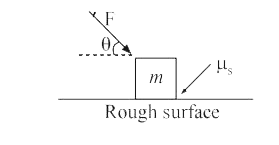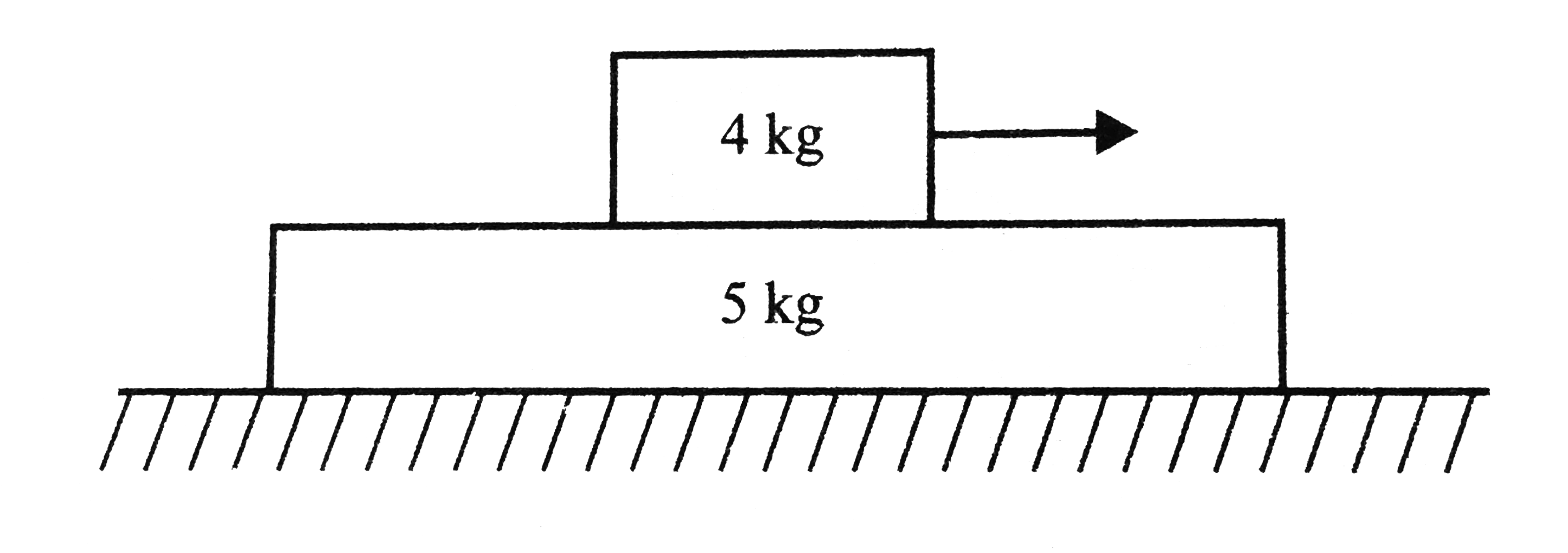A block is on horizontal slab which is moving horizontally and excuting S.H.M. The coefficient of static frication between block and slab is μ. If block is not separated from slab then determine range of angular frequency of oscillation.
To solve the problem of determining the range of angular frequency of oscillation for a block on a horizontally moving slab executing Simple Harmonic Motion (SHM), we can follow these steps:
Step 1: Understand the Forces Involved
We have a block of mass m resting on a slab that is moving horizontally and executing SHM. The coefficient of static friction between the block and the slab is μ. The block will not separate from the slab as long as the static friction can provide the necessary force to keep it in motion with the slab.
Step 2: Identify the Restoring Force
In SHM, the restoring force F acting on the block can be expressed as:
F=−kx
where k is the spring constant and x is the displacement from the equilibrium position.
Step 3: Relate Restoring Force to Acceleration
The acceleration a of the block due to the restoring force can be expressed as:
F=ma⟹a=Fm=−kxm
For maximum acceleration in SHM, we have:
amax=ω2A
where ω is the angular frequency and A is the amplitude of the motion.
Step 4: Frictional Force
The maximum static frictional force Ff that can act on the block is given by:
Ff=μmg
where g is the acceleration due to gravity.
Step 5: Condition for No Separation
For the block to remain on the slab without separation, the maximum restoring force must be less than or equal to the maximum static frictional force:
mamax≤μmg
Substituting amax=ω2A:
m(ω2A)≤μmg
Step 6: Simplifying the Equation
We can cancel m from both sides (assuming m≠0):
ω2A≤μg
This can be rearranged to find ω:
ω2≤μgA
Step 7: Finding the Range of Angular Frequency
Taking the square root of both sides gives:
ω≤√μgA
Thus, the range of angular frequency ω for which the block does not separate from the slab is:
0<ω≤√μgA
Final Answer
The range of angular frequency of oscillation is:
0<ω≤√μgA
---
We have a block of mass m resting on a slab that is moving horizontally and executing SHM. The coefficient of static friction between the block and the slab is μ. The block will not separate from the slab as long as the static friction can provide the necessary force to keep it in motion with the slab.
In SHM, the restoring force F acting on the block can be expressed as:
F=−kx
where k is the spring constant and x is the displacement from the equilibrium position.
The acceleration a of the block due to the restoring force can be expressed as:
F=ma⟹a=Fm=−kxm
For maximum acceleration in SHM, we have:
amax=ω2A
where ω is the angular frequency and A is the amplitude of the motion.
The maximum static frictional force Ff that can act on the block is given by:
Ff=μmg
where g is the acceleration due to gravity.
For the block to remain on the slab without separation, the maximum restoring force must be less than or equal to the maximum static frictional force:
mamax≤μmg
Substituting amax=ω2A:
m(ω2A)≤μmg
We can cancel m from both sides (assuming m≠0):
ω2A≤μg
This can be rearranged to find ω:
ω2≤μgA
Taking the square root of both sides gives:
ω≤√μgA
Thus, the range of angular frequency ω for which the block does not separate from the slab is:
0<ω≤√μgA
The range of angular frequency of oscillation is:
0<ω≤√μgA
Topper's Solved these Questions
- SIMPLE HARMONIC MOTIONBook:ALLENChapter:SIMPLE HARMONIC MOTIONExercise:SOME WORKED OUT EXAMPLES
Explore 29 Videos
- SIMPLE HARMONIC MOTIONBook:ALLENChapter:SIMPLE HARMONIC MOTIONExercise:Exercise-01
Explore 117 Videos
- RACEBook:ALLENChapter:RACEExercise:Basic Maths (Wave Motion & Dopplers Effect) (Stationary waves & doppler effect, beats)
Explore 24 Videos
- TEST PAPERBook:ALLENChapter:TEST PAPERExercise:PHYSICS
Explore 4 Videos
Similar Questions
A block of mass M is in contact with a cart of mass M. The coefficient of static friction between block and cart is μ . To prevent the block from sliding on cart, acceleration a should be
View SolutionA block of mass m is moving on a rough horizontal surface. μ is the coefficient of kinetic friction between the block and the surface. What is the net force exerted by the surface on the block?
View Solution
Knowledge Check
A block of mass 1 kg lies on a horizontal surface in a truck. The coefficient of static friction between the block and the surface is 0.6. If the acceleration of the truck is 5m/s2, the frictional force acting on the block is…………newtons.
A10NB5NC2.5ND20N
A block of mass M is kept on as rough horizontal surface. The coefficient of static friction between the block and the surface is μ. The block is to be pulled by applying a force to it. What minimum force is needed to slide the block? In which direction should this force act?
View SolutionA block of mass m slides down an inclined plane which makes an angle θ with the horizontal. The coefficient of friction between the block and the plane is μ. The force exerted by the block on the plane is
View SolutionA block of mass M is kept on as rough horizontal surface. The coefficient of static frictionbetween the block and the surface is μ. The block is to be pulled by applying a force to it. What minimum force is needed to slide the block? In which direction should this force act?
View SolutionA block is kept on a rough horizontal surface as shown. Its mass is 2 kg and coefficient of friction between block and surface (μ)=0.5. A horizontal force F is acting on the block. When

View SolutionWhat is the value of applied force ‘F’ which is exerted at an angle θ with the horizontal on a block of mass ‘m’ placed on a horizontal rough surface, if the coefficient of static friction between the block and the surface is , such that the block is on the verge of moving horizontally?

View SolutionA large slab of mass 5kg lies on a smooth horizontal surface, with a block of mass 4kg lying on the top of it. The coefficient of friction between the block and the slab is 0.25. If the block is pulled horizontally by a force of F =6N, the work done by the force of friction on the slab, between the instants t=2s and t=3s, is (g=10ms−2)

View SolutionA block of mass 1 kg lies on a horizontal surface in a truck. The coefficient of static friction between the block and the surface is 0.6. If the acceleration of the truck is 5m/s2, the frictional force acting on the block is…………newtons.
View Solution